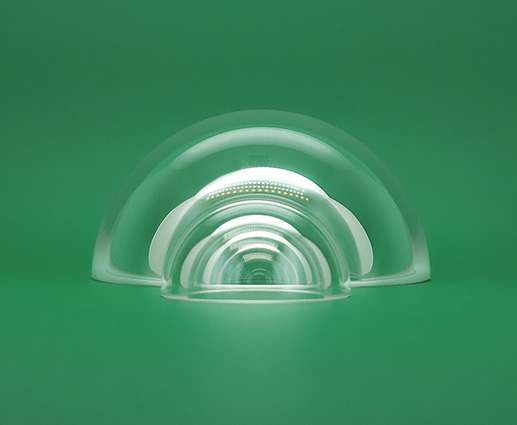Please contact our sales team.
For a quote on your custom requirements please send us your drawing or specification.
Optical Dome
Optical Dome is composed of two parallel optical surfaces. Among optics, domes are unique because, unlike any other optical components, the key attribute of the dome is to have no optical effect. Mirrors reflect light, lenses bend light, and domes ideally change nothing. Typically the lead element in an optical system, a dome is often exposed to the environment to resist wind & rain erosion for pyrometers, and as high-pressure viewports in underwater cameras and submersibles.
Optical domes are lenses with two concentric spherical surfaces. Sometimes they are referred to as bent-plan parallel plates. Consequently, it is customary to define parallelism between two surfaces as the maximum thickness variation between the two surfaces. In perfect domes, the convex radius is equal to the sum of the dome thickness and concave radius. Slight departures from that rule are sometimes desired.
These protection optical domes are high-quality optical products that are produced through precision polishing. They ensure clear, distortion-free protection for your camera objective or other sensitive equipment.
CLZ Optics has a rich stock of Optical Domes to ensure that we can respond quickly to customer needs. Our stock covers a variety of optical domes of various materials and specifications, including but not limited to optical glass domes, fused silica domes, sapphire domes, and silicon domes.
We not only provide products in standard sizes, but also support customized design and manufacturing according to customers' specific requirements to meet the needs of specific applications for optical performance and mechanical strength. With sufficient inventory and fast production cycles, CLZ Optics can provide customers with efficient and flexible solutions to ensure that projects are carried out on time without being affected by component supply delays. In addition, all products undergo a strict quality control process to ensure that every optical dome shipped has excellent consistency and reliability.
![]()
Please contact our sales team.
For a quote on your custom requirements please send us your drawing or specification.
Material Option >
Custom Capabilities >
Transportation >

Common materials for optical domes are H-K9L, equivalent N-BK7, N-BK10, N-K5, fused silica, and Silicon:
-H-K9L, N-BK7, N-BK10, and N-K5
They have similar characteristics, a relatively hard material, with excellent chemical durability, and wider transmission. These characteristics make them very suitable protection for Pyronometers' thermoelectric detectors.
-K9L and N-BK7
With excellent mechanical and chemical properties, also offer excellent transmission from 300nm up to 2µm, with very few bubbles and inclusions, making them perfect for high-performance visible applications. The thicker optical dome is ideal for underwater applications such as ROV, pipeline detection, and underwater probing and is widely used in the marine sector and underwater oil exploration. These materials are durable, waterproof, and corrosion-resistant, ensuring that the optical domes can withstand the pressure and corrosive properties of salt water.
1. Underwater ROV robot
These unmanned underwater vehicles are equipped with cameras and sensors that enable them to navigate and explore the underwater environment. By using optical domes, ROVs can capture high-quality images and data that are essential for a wide range of applications, including marine biology, geology, archaeology, and underwater infrastructure inspection.
2. Underwater photography
The Underwater Camera is a camera device designed specifically for underwater filming, with a superior performance optical dome to protect the camera from intense underwater pressure.
-Fused Silica
With excellent mechanical and chemical properties, UV quartz has high transmission at 200-400nm and IR quartz has excellent transmission from UV to NIR 3600nm. They are a good choice for high-quality Pyranometers, and UV Radiometers, and UV fused silica is also a common choice for underwater applications.
-Silicon
With good transmission in the IR, is used for Pyrgeometers.
The materials that can be customized are Optical Glasses, Fused Silica, Silicon:
| Materials | Dimension Range | |
| UV Fused Silica | Diameter 15 mm to 125mm | |
| IR Fused Silica | Diameter 15 mm to 100mm | |
| Optical Glasses | H-K9L from CDGM | Diameter 15 mm to 165mm with high-quality polishing |
| Diameter 165 mm to 280mm with commercial polishing | ||
| Optical glass from Schott or Ohara | Diameter 15 mm to 125mm | |
| Silicon | Diameter 15 mm to 80 mm | |
| Our shipping method | |||
| Optional carriers | DHL | UPS | FedEX |
| If you have your own express account | √ | √ | √ |
If you don't have your own express account,Shipping countries&Freight | Shipping cost is calculated according to the actual parcel weight and borne by the buyer; | ||
| General statute of limitations | 3-5 business days | 3-6 business days | 4-7 business days |
Please contact us for discount pricing for stock parts over 10+ and volume/OEM quantities
| Type No. | Data sheet | Material | Diameter (mm) | Thickness (mm) | Height of DOME | Unit Price | |
|---|---|---|---|---|---|---|---|
| CLZ-DOME-101B | PDF > | Fused Silica | 101 | 11.9 | 50.5 | $1,500.00 | |
| CLZ-DOME-065 | PDF > | H-K9L | 65 | 3 | 32.5 | $175.00 | |
| CLZ-Dome-075A | PDF > | H-K9L | 75 | 3 | 37.5 | $200.00 | |
| CLZ-Dome-075B | PDF > | H-K9L | 75 | 5 | 37.5 | $200.00 | |
| CLZ-Dome-076 | PDF > | H-K9L | 76 | 5.5 | 38 | $200.00 | |
| CLZ-Dome-094 | PDF > | H-K9L | 94 | 7 | 47.1 | $250.00 | |
| CLZ-Dome-100B | PDF > | H-K9L | 100 | 4 | 50 | $300.00 | |
| CLZ-Dome-101 | PDF > | H-K9L | 101 | 11.9 | 50.5 | $300.00 |
Now Shopping by
Related Categories